
43
Tạp chí phân tích Hóa, Lý và Sinh học - Tập 30, số 02/2024
POLYCYLIC AROMATIC HYDROCARBONS IN CHICKEN EGGS IN
VIETNAM: OCCURRENCE, DISTRIBUTION AND RISK ASSESSMENT
Đến tòa soạn 23-05-2024
Pham Thi Phuong1, Dao Hai Yen1, Tran Lam Thanh Thien2,3, Tran Huu Quang1*
1Institute of Chemistry, Vietnam Academy of Science and Technology
2Graduate University of Science and Technology, Vietnam Academy of Science and
Technology
3Institute of Mechanics and Applied Informatics, Vietnam Academy of Science and
Technology
*Email: hoasinhmoitruong.vast@gmail.com
TÓM TẮT
MỘT SỐ HYDROCARBON THƠM ĐA VÒNG TRONG TRỨNG GÀ TẠI VIỆT NAM:
SỰ XUẤT HIỆN, PHÂN BỐ VÀ ĐÁNH GIÁ RỦI RO
Hydrocarbon thơm đa vòng là nhóm hợp chất tương đối bền, dễ dàng phát tán trong môi trường thông qua
quá trình lắng đọng, đồng thời xâm nhập vào chuỗi thức ăn và gây ra những tác hại lâu dài đối với sinh vật
sống. Tuy nhiên, các nghiên cứu phân tích hàm lượng PAH trong thực phẩm (trứng gà) còn chưa được quan
tâm ở Việt Nam. Phương pháp phân tích PAH trong trứng gà được phát triển bằng việc sử dụng kỹ thuật
chiết QuEChERS cải tiến kết hợp kỹ thuật sắc ký khí ghép nối hai lần khối phổ (GC-MS/MS). Giới hạn phát
hiện và định lượng của phương pháp lần lượt từ 0,02–0,04 ng/g và 0,10–0,90 ng/g. Hiệu suất thu hồi của
các PAH nằm trong khoảng 82,2–103,5%, với giá trị lệch chuẩn tương đối nhỏ hơn 15%. Phương pháp
được áp dụng trong phân tích 100 mẫu trứng gà thuộc hai nhóm gà thả rông và gà nuôi chuồng, với hàm
lượng PAH trong lòng đỏ và lòng trắng dao động trong khoảng 15,8–50,5 ng/g và 2,4–13,1 ng/g lipid. Đồng
thời, kết quả phân tích mẫu trứng cho thấy sự phân bố PAH trong các phần trứng gà có liên quan đến giá trị
log kow và tỷ lệ thành phần lipid. Chỉ số rủi ro (HQ) được xác định thông qua hàm lượng tiêu thụ ước tính
hằng ngày đều nhỏ hơn 1, chứng tỏ mức độ rủi ro trực tiếp đối với sức khỏe con người thông qua việc tiêu
thụ trứng gà tại Việt Nam là không đáng kể.
Từ khóa: Hydrocarbon thơm đa vòng, QuEChERS, GC-MS/MS, trứng gà, Việt Nam.
1. INTRODUCTION
Polycyclic aromatic hydrocarbons (PAHs) are
persistent organic pollutants established from at
least two aromatic rings without heteroatoms or
substituents [1]. PAHs possess all the
characteristics of aromatic hydrocarbons as a
result of their structure, which is made up of
benzene rings. The toxicity of PAHs is defined by
their molecular structure, which may cause
prenatal abnormalities, cancer, and
immunotoxicity in numerous organisms, including
microbes, animals, and humans [2]. Notably, the
concentration, accumulation, exposure
mechanism, and characteristics of PAHs are the
main variables that influence their impact on
human health. Besides, the cancer risk of PAHs is
assessed to increase gradually via inhalation, skin
exposure, and ingestion [3]. The primary sources
of PAHs emissions are human activities and
natural sources, most frequently the incomplete
combustion of organic materials followed by
release into the environment. The presence of
PAHs has also been found in foods, including fish,
tea, meat products, fruits and vegetables [4]. Due
to the various existences of PAHs in the
environment and their negative effects, the

44
regulation on PAHs concentration thresholds has
been proposed. PAHs are chemical in drinking
water for which the European Union (EU) has
established a total concentration of B[b]F, B[k]F,
B[ghi]F, IP accordingly not be higher than 0.10
µg/L and B[a]P level not exceed 0.01 µg/L [5]. In
2020, the Commission Regulation issued
regulation No. 1255/2020 on the maximum levels
of PAH4 (benzo[a]anthracene, chrysene,
benzo[b]fluoranthene, benzo[a]pyrene) in smoked
meat products/ fish is not to exceed 30 µg/kg.
Furthermore, the newer regulation established the
maximum allowable levels in plant-based powders
for BaP and PAH4 at 5.0 and 50 µg/kg,
respectively [6]. Several investigations conducted
in Vietnam have shown the existence of PAHs in
both environmental samples and in food that is
directly ingested by humans [4, 7, 8]. The total
concentrations of 22 PAHs were observed in the
range of 52–920 ng/g dry weight in surface
sediments in Hanoi [4, 8]. For various food
samples, average levels of 18 PAHs were found in
the ranges of 9.3–9.6 µg/kg (instant noodles),
0.22–2.48 µg/kg (pastries), 5.14–23.32 µg/kg (tea)
or 1.43–25.2 µg/kg (grilled meat) [4].
Nevertheless, there is a lack of studies about their
existence in animal-derived foods. Notably,
controlling the level of PAHs in laying hen eggs is
urgent since Vietnam still has insufficient
regulations governing the food safety derived from
animals. The aims of this study include: (1)
analyzing the PAHs concentration in chicken egg
samples; (2) evaluating the PAHs distribution in
the albumen and yolk; and (3) estimating the
exposure risk to human health via chicken egg
consumption.
2. MATERIALS AND METHODS
2.1. Chemical and reagents
The mixture standard of 16 PAHs (QTM PAH
Mix 2000 μg/mL each component in
dichloromethane) including naphthalene,
acenapthylene, acenaphthene, fluorene,
phenanthrene, anthracene, fluoranthene, pyrene,
benz[a]anthracene, chrysene,
benzo[b]fluoranthene, benzo[k]fluoranthene,
benzo[a]pyrene, benzo[g,h,i]perylene,
dibenz[a,h]anthracene, indenol[1,2,3-c,d]pyrene
were supplied by Merck (Darmstadt, Germany).
The isotopic standards were provided by Dr.
Ehrenstorfer GmbH (Augsburg, Germany),
consisting of benzo[a]anthracence-13C6 and
benzo[g,h,i]pyrylene-13C12. Organic solvents (n-
hexane, acetonitrile (MeCN)) were purchased
from Merck. Ultra-pure water (UPW) was
provided by the Milli-Q-Integral system from
Merck Millipore (Burlington, MA, USA). MgSO4
and NaCl salts were purchased from Merck. The
purified materials (PSA, C18) were supplied by
Agilent (Santa Clara, CA, USA).
2.2. Sample collection
In 2023, 100 chicken egg samples were purchased
in batches in Hanoi, which were classified into
two groups, including battery-cage (n = 47) and
free-range (n = 53). Chicken eggs are carefully
separated into yolk and albumen, then were
contained in aluminum foil tarts that have been
previously rinsed with methanol. The egg yolk
must be separated intact without breaking the
surrounding membrane. The egg samples were
stored at -20 °C until analysis. The same
methodology as in the prior study was applied to
measure the lipid content in albumen or yolk [9].
2.3. GC-MS/MS
The GC-MS/MS system included a Trace GC
1310 gas chromatograph, a TriPlus RSH
autosampler, and a TSQ Dashboard 9000 mass
spectrometer (Thermo Fisher Scientific, Waltham,
MA, USA). A DB5-MS column (30m × 0.25mm,
0.25 µm) was utilized to separate the PAHs. The
temperature gradient program is illustrated as
follows: maintain at 70 °C for 1 min, rapidly
increase to 150 °C (25 °C/min), then gradually
increase to 200 °C (3 °C/min), and finally increase
to 280 °C (8 °C/min, hold 13 min). The total
analysis time was 45 minutes. Helium gas was
employed as a carrier gas at a rate of 1 mL/min. In
splitless mode, the injection volume was 1 µL.
The triple quadrupole mass spectrometer was used
in electron ionization mode with an energy of 70
eV. The temperatures assigned to the inlet, transfer
line and ion source were 250 °C, 280 °C, and 230
°C, respectively. The mass analyzer parameters
were based on the previous study [4].
2.4. Sample preparation
The QuEChERS extraction method was applied
based on a previous study and some modifications
[4]. Briefly, 1 g of the freeze-yolk or albumen
sample was transferred to a 50-mL centrifuge
tube. Afterward, 10 µL of isotopic standard (50
µg/g) were added to the tube and allowed to

45
equilibrate for 15 min. Then, a 10 mL solvent
containing UPW:MeCN (v/v, 9/10) was
transferred to the tube and it was vortexed for 1
min. A mixture of 4 g MgSO4 and 1 g NaCl was
also added, gently shaken and vortexed for 5 mins.
Subsequently, the sample tube was centrifuged at
7000 g for 10 min. Then, 5 mL of the
supernatant was collected, transferred and
vortexed for 2 minutes in another falcon tube
containing 200 mg primary secondary amine
(PSA) and 200 mg C18. Then, the tube was
immediately centrifuged for 5 mins at 7000 g.
After that, 3 mL of the supernatant was
concentrated to dryness under a stream of nitrogen
gas at 1 °C and reconstituted with 1 mL of n-
hexane. The extract was lastly filtered through a
0.22-µm PTFE membrane into a dark glass vial
before GC-MS/MS analysis.
2.5. Method validation
The method for determining PAHs in egg sample
by GC-MS/MS system was validated in
accordance with the European Commission
(SANTE/11312/2021). A linear range was
established in the range of 1-100 ng/mL, with all
regression coefficients (R2) obtained being greater
than 0.995. Repeatability and reproducibility were
evaluated through the relative standard deviation
(RSD) at three spiked concentration levels in egg
blank samples. The experiment was repeated six
times at each spiked concentration level and
continuously for three days. The observed RSD
was within the permitted range of 2.1–10.5 (less
than 15%). The method detection limit (MDL)
was determined via PAHs quantification of the
egg sample with an S/N ratio of at least 3. The
PAHs standard solution mixture was spiked into
the egg sample, which ensured that no PAHs
signals were detected previously. The method
quantification limit (MQL) was calculated as
MQL = 10SDblank. The MDL and MQL for PAHs
were in the range of 0.02–0.04 ng/g and 0.10–0.90
ng/g, respectively. Likewise, the matrix effect was
recorded in the range of -7.2–11.2%, aligning with
the guidance given in SANTE/11312/2021.
2.6. Health risk assessment
The exposure risk of PAHs to human health via
chicken egg consumption was evaluated by risk
category [3]. For PAHs non-carcinogenic hazards,
the average daily dose (ADD) was calculated
according to formula (1):
(1)
For PAHs carcinogenic hazards, the lifetime
average daily dose was estimated based on
formula (2):
(2)
Then, Hazard Quotients (HQ, %) for non-
carcinogenic PAHs were determined as follows:
(3)
Where C is the mean concentration for each PAH
(mg/kg), while B[a]P is calculated using the
equivalent concentration C B[a]P = C TEF; IR is
the digestion rate of food (kg/day); EF is exposure
frequency (day/year) assuming a consumption
level of 365 days; ED is exposure duration (years),
with a value of 7.0 years for children and 34.5
years for adults; AT is the average time (70 years
365 days); RfD is the chronic oral reference
dose (mg/kg-day). BW applicable to children and
adults is 15 kg and 60 kg, respectively.
3. RESULTS AND DISCUSSION
3.1. PAHs in chicken eggs
The results of PAHs concentration in yolk and
albumen of the collected chicken egg samples
were presented in Table 1. The yolk/albumen
weight ratio data were gathered to determine
PAHs levels in whole eggs. The PAHs level in
whole eggs was estimated as follows: [PAH]whole
egg = [PAH]yolk %myolk + [PAH]albumen
%malbumen. Yolk and albumen had respective
average weight ratios of 32% and 68%. Besides,
PAHs concentration was converted from initial
data (ng/g-ww) to processed data (ng/g-lw)
according to the formula:
. Whereby, the albumen and yolk
had typical lipid content ratios of 30% and 0.2%,
respectively. Overall, most PAHs were detected in
both yolk and albumen. As a result, 12 of 16
PAHs were observed to have detection frequencies
(DF) greater than 50% for yolk and whole eggs.
On the other hand, 4 of 16 PAHs, including NaP,
ACNP, ACP and Fl had DF < 30%, with the mean
level not exceeding 1.95 ng/g-lw. The PAHs
concentrations in yolk and albumen were 15.8–
50.5 ng/g-lw (with a mean of 30.5 ng/g-lw) and
2.4–13.1 ng/g-lw (with a mean of 7.59 ng/g-lw),
respectively. Notably, B[ghi]P, DBA, IP were

46
compounds found in high concentrations in both
yolk and albumen. Meanwhile, NaP, ACNP, ACP,
Fl had DF ranging from 2–8% in the yolk to 2–9%
in whole eggs, which was negligible or not
detected in the albumen fraction (0–2%). The
PAHs concentration in chicken eggs was found to
be lower than in seabird eggs in Northwest
Iberian, with a concentration range (mean) of
48.6–747.1 µg/kg-dw (187.1 µg/kg-dw) [5]. The
comparable PAHs level reported was
substantially inferior to that of chicken eggs
examined during multiple weeks of gathering in
Minas Gerais, Brazil (0.926–1.668 µg/g) [10].
These results suggested that the PAHs distribution
in chicken egg fractions was influenced by
logarithm of n-octanol/water partition coefficient
(log KOW). Whereas more polar molecules were
detected in albumen, lipophilic compounds
commonly existed in yolk [11]. As a result, PAHs
chemicals with a larger log KOW typically
spreaded mostly in the hydrophobic phase, which
was in keeping with the greater lipid composition
level in yolk. Notably, there had been a lack of
studies indicating the PAH distribution in egg
fractions. Nevertheless, this distribution was noted
for a number of other categories of organic
pollutant substances. For instance, tissues
absorbed up to 80% of the yolk's lipid content,
with higher PBDEs and PCBs concentrations
exhibiting a higher log KOW [12]. On the other
hand, OPEs were more concentrated in albumen.
Although egg metabolism normally enhanced
compound polarity and lowers lipophilicity, OPEs
metabolism tended to accumulate in the yolk due
to protein formation in the yolk and albumen
synthesis [11]. To provide a clearer representation
of the findings, PAHs were split into five groups:
di-, tri-, tetra-, penta-, and hexa-cyclic. Significant
variations in the PAHs group concentration and
kind of egg were discovered (t-test, p<0.05). For
instance, there was a noticeable variation between
battery-cage and free-range chicken eggs in terms
of the mean level of tri-cyclic, tetra-cyclic, and
hexa-cyclic. It further emerged the average
concentrations of PAHs varied throughout each
group. The existence of PAHs in the ecological
environment (soil, surrounding air) and the
chicken-growing procedure (water, poultry feed)
could represent an explanation of these
discrepancies [13]. These exposure sources were
more likely for free-range hens than for battery-
cage hens [14]. Furthermore, the predominant
existence of larger PAHs (≥4 cyclics) was
considered to be more challenging to metabolize
than less cyclic PAHs.
Table 1. Detection frequency (DF, %) and concentration (ng/g-lw) of PAHs in albumen, yolk and whole egg
samples from Hanoi, Vietnam.
Compound
Yolk
Albumen
Whole egg
DF (%)
Range (Mean)
DF (%)
Range (Mean)
DF (%)
Range (Mean)
NaP
2
1.5 – 2.4 (1.95)
0
<MDL
2
0.48 – 0.77 (0.62)
ACNP
6
0.6 – 1.6 (1.02)
1
0.6
7
0.19 – 0.51 (0.34)
ACP
7
0.5 – 3.1 (1.76)
1
1.0
8
0.16 – 0.96 (0.59)
Fl
8
0.5 – 3.1 (1.43)
2
0.5 – 1.0 (0.75)
9
0.16 – 1.17 (0.52)
PHN
85
0.1 – 3.1 (1.72)
31
0.5 – 2.0 (0.89)
86
0.03 – 2.03 (0.76)
AN
91
0.2 – 4.0 (1.78)
35
0.5 – 1.7 (0.94)
95
0.06 – 1.83 (0.78)
Py
100
0.3 – 3.8 (1.64)
47
0.5 – 1.9 (0.80)
100
0.10 – 1.76 (0.78)
FLA
88
0.1 – 5.2 (2.21)
54
0.5 – 2.1 (0.95)
93
0.03 – 2.90 (1.04)
Chy
92
0.1 – 6.1 (2.23)
55
0.5 – 2.1 (1.11)
97
0.10 – 2.77 (1.12)
B[a]A
93
0.3 – 6.3 (2.80)
74
0.3 – 3.0 (1.02)
98
0.10 – 2.71 (1.38)
B[b]F
95
0.7 – 6.5 (2.56)
67
0.5 – 2.4 (1.03)
99
0.29 – 3.10 (1.26)
B[k]F
97
0.3 – 6.0 (2.81)
73
0.4 – 2.6 (1.02)
100
0.19 – 2.62 (1.38)
B[a]P
96
0.3 – 7.0 (2.93)
75
0.1 – 2.5 (0.98)
99
0.13 – 2.63 (1.42)
B[g,h,i]P
94
0.2 – 6.4 (3.05)
76
0.3– 3.0 (1.15)
99
0.22 – 3.06 (1.53)
DBA
97
0.4 – 8.7 (3.83)
74
0.3 – 3.0 (1.10)
99
0.13 – 3.96 (1.78)
IP
97
0.2 – 9.4 (4.36)
72
0.3 – 3.0 (1.16)
98
0.06 – 4.47 (1.96)
PAHs
100
15.8 – 50.5 (30.5)
100
2.4 – 13.1 (7.59)
100
9.07 – 22.8 (14.9)

47
Figure 1. The variable loadings are represented by the principal component analysis (PCA) of PAHs.
For 12 PAHs (DF > 50%) in all egg samples,
principal component analysis (PCA) was applied
in order to indicate the relationship between
poultry production methods and PAHs chemicals
(Figure 1). The first three PCs explained 51.1% of
the total sample variance. Of which PC1, PC2,
PC3 accounted for 20.7%, 17.9% and 12.5%,
respectively. As a result, indeno[1,2,3-c,d]pyrene
(IP), dibenz[a,h]anthracene (DBA) and
fluoranthene (FLA) function as predominant key
loadings in the first three PCs, respectively. In
detail, the recorded percentage explaining the
variance of IP, DBA, FLA in PC1, PC2, PC3 were
87.5%, 54.0% and 35.5%, respectively. These
three PAHs were harder to eliminate from the
poultry body that they accumulated and entered
the following products due to their multiple-ring
structure [6]. Furthermore, IP, DBA and FLA
contributed significant variance percentages,
meaning that even a slight variation in their
concentration in chicken feed might impact the
coordinates of sample points position on the PC
score-plot. Thus, more investigations were
required to testing the PAHs presence in animal
feed due to their high toxicity.
3.2. Dietary exposure to PAHs
The average daily dose (ADD) and the lifetime
average daily dose (LADD) by age group were
estimated and presented in Table S1. For non-
carcinogenic effects, the average daily dose varied
from 7.74E-09 to 5.71E-07 mg/kg-day and 1.93E-
09 to 1.43E-07 mg/kg-day for children and adults,
respectively. B[g,h,i]P had the highest ADD value,
followed by FLA and Py, while NaP had the
lowest value. Comparably, the lifetime average
daily dosage for carcinogenic effects was 4.17E-
08–8.41E-08 mg/kg-day in children and 5.13E-
08–1.04E-07 mg/kg-day in adults. The PAHs in
this category with the highest LADD were DBA
and IP, whereas Chy had the lowest. Overall, the
estimated ADD was stronger in children than
adults, which was the opposite for LADD. The
estimated exposure parameters between two PAHs
groups and by age group were examined without
statistically significant differences (p<0.05).
Hazard Quotient (HQ) was observed for the group
of PAHs non-carcinogenic hazards in the range of
9.67E-06–1.09E-03 mg/kg-day. HQ values were
significantly less than 1, indicating a low potential
that consuming chicken eggs in Vietnam directly
endangers human health.
4. CONCLUSION
This study provided an effective method for
accurately and sensitively analyzing PAHs in
chicken egg samples. The recovery efficiency of
PAHs was in the range of 82.2–103.5%
(RSD<15%). The study then evaluated the
distribution of PAHs in chicken egg parts of two
free-range and battery-cage species. The findings
indicated that naphthalene, acenaphthylene,
acenaphthene and fluorene had poor detection
frequencies (DF<10%), while the remaining PAHs
had greater detection frequencies (DF>50%).
There was a significant variance in the mean
concentration of PAHs between the two types of
chicken eggs (p<0.05). The PAHs level
determined in chicken egg samples was found to
be acceptable; even so, further reporting
requirements and stringent control procedures
would be essential in the future.
Acknowledgement. This research has received
funding from the Vietnam Academy of Science

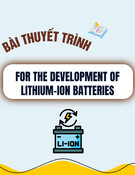
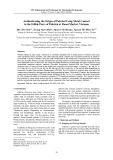

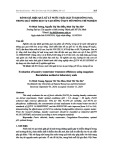
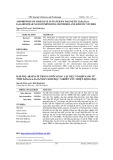
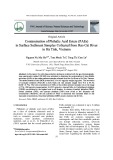
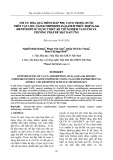

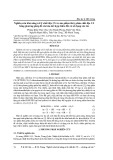
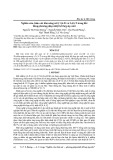

![Tài liệu Vi sinh vật môi trường [Mới nhất]](https://cdn.tailieu.vn/images/document/thumbnail/2025/20251123/ngkimxuyen/135x160/21891763953413.jpg)
![Sổ tay truyền thông Phân loại chất thải rắn sinh hoạt trên địa bàn tỉnh Quảng Nam [Chuẩn nhất]](https://cdn.tailieu.vn/images/document/thumbnail/2025/20251114/kimphuong1001/135x160/1701763094001.jpg)


![Quản lý chất thải nguy hại: Sổ tay Môi trường [Chuẩn nhất]](https://cdn.tailieu.vn/images/document/thumbnail/2025/20251029/kimphuong1001/135x160/9011761720170.jpg)









